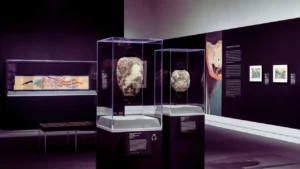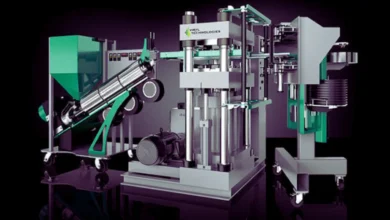Museum Of Jurassic Technology Mysteries In LA

Tucked away in the unassuming neighborhood of Culver City, Los Angeles, the Museum of Jurassic Technology stands as one of the most enigmatic attractions in California. From the outside, it appears like a quaint storefront, but stepping inside feels like entering a realm where fact and fiction blur into a surreal narrative. This is not your ordinary museum. It doesn’t follow the rules of logic or science in the traditional sense; instead, it invites visitors into a bizarre world filled with peculiar exhibits, forgotten histories, and poetic absurdity that challenge the boundaries of belief.
Founded by David Hildebrand Wilson and opened to the public in the late 1980s, the museum blends pseudo-scientific oddities with obscure cultural artifacts, making visitors question the authenticity of everything they see. Is it satire, serious art, or something in between? That’s part of the mystery. Stories of humans with bat wings and tiny sculptures on a pin’s head are among the exhibits. Each room is dimly lit, almost reverent, pulling you deeper into a rabbit hole of curiosities that leave you both bewildered and intrigued. The experience is less about learning and more about feeling, questioning, and reimagining what a museum can be.
A Place Where Fact And Fiction Collide
In the heart of Los Angeles lies a place that baffles, intrigues, and mesmerizes anyone who steps inside The Museum of Jurassic Technology. This mysterious institution defies categorization. It is neither wholly fictional nor a science museum in the conventional sense. Instead, it artfully blurs the boundaries between fact and myth, history and imagination. Dimly lit halls visitors through exhibits that range from obscure scientific marvels to bizarre cultural tales. Some displays are based on truth, others on elaborate storytelling, yet all are presented with equal seriousness.
The museum invites visitors to question their perception of knowledge and authenticity. From microscopic sculptures to eccentric biographies, each piece is curated to evoke curiosity and contemplation. It’s an intellectual funhouse where skepticism is welcome, and nothing is quite what it seems. The museum doesn’t just display information—it creates an experience that lingers long after you leave.
Basic Information About The Museum
David Hildebrand Wilson established the Museum of Jurassic Technology in the late 1980s, and it is situated in Culver City, Los Angeles. It operates as a non-profit cultural institution blending fact, fiction, and artistic expression. The museum remains open to the public year-round, welcoming those intrigued by curiosity and mystery.
| Feature | Description |
| Name | Museum Of Jurassic Technology |
| Location | 9341 Venice Blvd, Culver City, Los Angeles |
| Founded | 1988 |
| Founder | David Hildebrand Wilson |
| Type | Experimental / Conceptual Museum |
| Operating Hours | Wed–Sun, Noon To 6 PM |
The Museum’s Unique Curatorial Approach

Rather than offering straightforward explanations or academic certainty, the Museum of Jurassic Technology thrives on ambiguity. Each exhibit is carefully crafted to walk a tightrope between the plausible and the absurd. Visitors may stumble upon tales of physicists living in trailers who claim to receive messages from space or accounts of Soviet-era experiments on canine memory—all presented with the same solemnity as a natural history museum. Labels are sparse, often poetic or deliberately vague, avoiding clear distinctions between fact and fiction.
This curatorial detachment forces guests to slow down and reflect rather than simply consume information. It’s a rare space where curiosity is tested rather than satisfied. Instead of delivering clear narratives, the museum raises silent questions about what we accept as truth. The result is a deeply immersive, cerebral experience that redefines how a museum can engage with its audience.
Founders And Their Philosophy
David Wilson, the visionary behind the Museum of Jurassic Technology, designed it not to inform but to provoke. Rather than follow traditional museum models focused solely on education, he crafted a space that invites introspection, ambiguity, and poetic interpretation. Wilson’s work questions the very essence of a museum—should it be a house of knowledge or a place for imaginative storytelling? His answer: it can be both. Through carefully curated oddities and mystifying presentations, he pushes visitors to reconsider the line between fact and fiction. The museum stands as an ode to curiosity, creativity, and the beauty of the unknown.
Aesthetic And Environment
The museum’s interior is intentionally surreal, composed of dimly lit corridors, richly grained wood, velvet drapes, and antique display cases that seem untouched by time. Ambient sounds, murmuring narrations, and occasional flickers of light create a meditative rhythm throughout the space. Every design choice is deliberate, shaping an environment that blurs perception and pulls visitors inward. The atmosphere feels less like a museum and more like a lucid dream. In this dark and hushed sanctuary, exhibits are elevated beyond information—they become immersive, emotional, and deeply personal experiences.
Exhibit Themes Found In The Museum
There are several odd and unusual display themes at the Museum of Jurassic Technology. These include scientific anomalies, poetic pseudo-histories, obscure biographies, and micro-miniature art. Some displays cover early medical devices and folk remedies, while others delve into metaphysical subjects or cultural superstitions.
| Exhibit Theme | Description |
| Microminiature Sculptures | Art Pieces Invisible To The Naked Eye Without A Microscope |
| Sonnabend’s Disease | Fictional Medical Conditions Presented As Clinical Case Studies |
| Soviet Space Dogs | Displays On The Memory Of Space-Traveling Canines |
| Athanasius Kircher’s Works | Mix Of Historical Fact And Speculative Biography |
| Mobile Home Physics | Tales Of Reclusive Physicists And Space Transmissions |
| Floral Radiographs | X-Ray Images Of Flowers Made Into Artistic Expressions |
The Art Of Misdirection
The Museum of Jurassic Technology’s masterful use of deception is largely responsible for its mysterious charm. Through scientific jargon, formal academic tone, and traditional museum aesthetics, it builds an illusion of credibility that makes even the most outlandish claims seem plausible. Visitors are gently led into believing what they see—until doubt creeps in. The lighting, tone, and authoritative voice overs create a convincing aura of authenticity.
But beneath the surface lies a challenge to perception itself. The museum doesn’t demand belief; it encourages critical thinking. Its real power lies in the subtle suggestion that truth is not always absolute—and that even deception, presented poetically, can reveal deeper truths. It’s not about what’s real—it’s about how meaning is made.
Cultural Impact And Popularity
Despite its perhaps because of it, the Museum of Jurassic Technology has become a cult favorite among thinkers, creators, and curious minds. It has been featured in documentaries, praised in academic circles, and referenced in books exploring the blurred lines between reality and imagination. Artists, philosophers, and even scientists admire its bold defiance of conventional museum norms. Visitors consistently report a unique blend of awe, confusion, humor, and inspiration after touring the exhibits. It’s one of the few places where walking away with more questions than answers feels like the entire point. The museum continues to inspire new interpretations with every visit.
Educational Value In A Nontraditional Format
The Museum of Jurassic Technology offers instructors and students an engaging and unique educational opportunity. Rather than offering concrete facts, it challenges visitors to think critically about the nature of information itself. Teachers frequently use the museum as a springboard for discussions on media literacy, encouraging students to question how narratives are constructed and how authority is established.
In today’s world of misinformation and manipulated media, this kind of engagement is more valuable than ever. The museum doesn’t provide direct answers—it teaches how to ask better questions. It becomes a living classroom where ambiguity becomes a tool for insight. By navigating its halls, learners sharpen their analytical thinking and reflect on the deeper meaning of knowledge.
Mystical Experiences And Visitor Testimonies
Many visitors describe their time at the Museum of Jurassic Technology as spiritual, surreal, or even transformative. The dim lighting and mysterious layout lull guests into a dreamlike state where time seems to slow down. Unusual artifacts and poetic displays evoke deep emotional responses—some laugh in disbelief, while others are moved to tears. It’s common to hear whispers of awe as people encounter exhibits that defy explanation. The overall atmosphere encourages introspection and a quiet sense of reverence. For many, the experience lingers like a vivid dream long after they’ve left.
Wrapping Up
In the end, the Museum of Jurassic Technology isn’t just a building filled with strange objects—it’s a philosophical journey through uncertainty, wonder, and imagination. Every exhibit challenges perception, inviting visitors to rethink reality, history, and belief itself. It doesn’t provide answers but rather opens doors to new questions. The dim lighting, cryptic labels, and surreal ambiance are all part of the deliberate puzzle. As you walk through the labyrinth of artifacts, you’re caught in a world where truth and fiction blend seamlessly.
Some visitors leave amused, others puzzled—but none untouched. The museum’s strength lies in its ability to provoke thought rather than deliver facts. Whether you see it as satire, art, or genuine scholarship, the experience stays with you. This strange corner of LA offers more than curiosity—it offers a deep, haunting sense of wonder. For those brave enough to question what they think they know, it’s an unforgettable destination.
FAQs
What does the Museum of Jurassic Technology aim to achieve?
The Museum of Jurassic Technology’s mission is purposefully vague and provocative. It challenges traditional expectations of what a museum should be. Instead of offering facts for passive consumption, it invites visitors to the boundaries between truth, myth, and interpretation. The museum blurs reality and fiction in a way that makes you question your assumptions.
Are the exhibits in the museum real or fake?
The exhibits in the museum range from entirely factual to imaginative fiction, with many blending the two seamlessly. The museum does not label or separate real from fake, and that’s part of its unique experience. Instead, it presents each piece with academic precision, making it feel authentic regardless of its origin. This approach forces visitors to rely on their judgment and skepticism.
Can children visit the Museum of Jurassic Technology?
Yes, children can visit, but it depends on their age and interests. The museum is quiet, dimly lit, and filled with abstract ideas and subtle themes that may not appeal to very young kids. However, older children, particularly those with a love for science, storytelling, or unusual art, may find it incredibly intriguing. It’s not a hands-on or interactive place like a children’s science center. Instead, it rewards patience, imagination, and curiosity.
How long does a typical visit take?
A typical visit to the Museum of Jurassic Technology usually takes about 1.5 to 2.5 hours. However, some visitors find themselves spending much longer exploring every corridor, reading every placard, and reflecting on the museum’s layered content. There’s no path or required sequence, which means you’re free to wander at your own pace. Short films in the theater room and the rooftop tea service also extend your visit.
Is photography allowed in the museum?
No, photography is generally not allowed inside the Museum of Jurassic Technology. This rule is part of preserving the surreal, immersive experience the museum curates so carefully. Without the distraction of cameras, visitors tend to engage more directly and deeply with the exhibits. The dim lighting and quiet ambiance are also better maintained without camera flashes or shutter sounds.
What are some of the most talked-about exhibits in the museum?
Several exhibits at the museum have gained legendary status among frequent visitors. These include the story of Athanasius Kircher’s cat piano from the 17th century and the tiny sculptures carved on pin heads. Another crowd favorite is the section on bat communication and memory experiments involving Soviet dogs. There’s also an eerie room featuring pre-scientific medical devices and another on trailer-dwelling physicists allegedly receiving space transmissions.
Is the Museum of Jurassic Technology worth visiting for first-time tourists in LA?
Especially for those who enjoy the unusual, the philosophical, or the surreal. It’s unlike any other attraction in Los Angeles and offers a stark contrast to the city’s more glamorous, fast-paced highlights. The museum is calm, quiet, and strange in all the right ways. First-time visitors looking for something off the beaten path often find it refreshing and intellectually stimulating.



